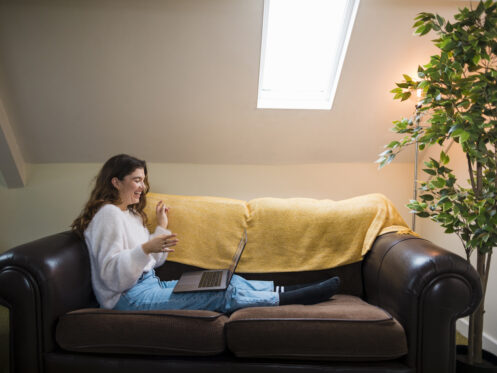Natural light dramatically enhances both the functionality and feel of a space. If you want to introduce natural light into a room in your home, one of the best and most beautiful ways of doing this is through a skylight. However, picking the best skylight for your home’s roof is more than just picking something that’s the most attractive; you need to consider what kind of roof you have, ventilation requirements, lighting needs, and long-term maintenance. Let this guide shine some light on these factors so you can make an illuminated decision.
1. Consider Your Roof Type
There might be specific skylight designs that you find alluring, but you need to understand your roof type and pitch. Both impact the kinds of skylights available to you and their associated installation processes. For instance, a flat roof typically needs specialized tubular or domed skylights to prevent pooling and ensure water runoff. A pitched roof offers more design flexibility because standard skylights work well on slopes. Installation might be easiest with asphalt shingle roofing that’s compatible with most skylight categories. Tile or metal roofs might need mounting kits or extra flashing to ensure watertight sealing.
The pitch of your roof will also impact the placement of a potential skylight. A steeper roof lets a skylight gather more light all day long, whereas a lower-pitch roof might need careful angling for optimal sunlight.
2. Assess Your Lighting and Ventilation Needs
Consider what you want your skylight to accomplish in your home. One can brighten a room, but it can also regulate temperature, improve ventilation, and possibly reduce your energy costs. The primary benefit is, of course, illumination. Skylights reduce how much artificial lighting you need. Increasing exposure to natural light boosts productivity and mood. If you want constant light in certain rooms, such as a kitchen, living room, or studio, pick a fixed or larger skylight.
Ventilation is important, and a venting skylight can reduce heat or humidity in a kitchen, bathroom, or attic; these can open electronically or manually, so they improve indoor air quality and help circulate air. Homes in colder climates can use skylights as passive solar heating that reduces the workload on active heating systems during daylight hours.
3. Types of Skylights
Not every skylight is the same, and the kind you pick should cater to your roof, home’s design, and household needs. A fixed skylight doesn’t open but can provide effective light transmission, especially for rooms that need more light but not ventilation. A ventilated skylight can be opened by remote or manually, and some models even have rain sensors to automatically close them during precipitation.
Dome skylights are common installations on flat roofs because they offer durability and let rainwater flow freely away from them. Custom skylights are possible when you have a specific aesthetic in mind or have unique architecture, as they can fit unusual design preferences or rooflines.
4. Key Features to Look For
Modern skylights have multiple features contributing to the comfort, functionality, and efficiency you might be looking for. Low-E glass is a coating that keeps your home warmer in winter and cooler in the summer by reducing heat transfer. Tinted or frosted glass options increase privacy and reduce glare, and motorized controls are great for hard-to-reach skylights, so you can remotely operate opening, closing, and adjustments to blinds. Built-in shades or blinds can be manual or motorized and regulate heat and light. UV-filtered glass provides protection for artwork, flooring, and furniture you don’t want to fade over time.
5. Professional Installation and Flashing Are a Must
Even a great skylight risks eventual failure if the installation isn’t done properly. One of the more frequent issues homeowners face with their skylights is leakage, and that’s usually the result of improper sealing or poor flashing. A roof’s flashing is a crucial component, creating a watertight barrier between the skylight and the surrounding roofing, and it needs to be fitted by a professional who can match your roof slope and type. Installation should always be handled by qualified professionals. Incorrect angle or placement can result in energy inefficiency, structural problems, and water damage. If you’re looking for a new skylight to replace an older model, the potential retrofitting might need to install new flashing and adjust the roof opening.
6. Maintenance and Longevity
Routine maintenance is important if you want to keep your skylight in great condition. Cleaning the glass on a regular basis removes debris, dirt, and water spots. Once a year, someone should inspect the flashing and seals; this is particularly important before and after any regional storm seasons. Watch for signs of leaks or condensation inside your home that might indicate complications with the flashing or insulation. Replace any worn-down gaskets or weather stripping to maintain an airtight seal. A high-caliber skylight can last two decades or even longer with effective care.
7. Energy Efficiency and Home Value
You can use a skylight to improve the energy efficiency of your home. Some models are rated with Energy Star certification and can reduce your dependence on indoor artificial lighting. When paired with the right ventilation features and glazing, they might even help regulate the temperatures inside your home. Skylights add aesthetic benefits but can also boost your home’s resale value. Many aspiring homebuyers appreciate the open and airy feel a skylight adds. Just make sure your skylight is installed professionally and then maintained properly so it’s an asset instead of a liability.
Frequently Asked Questions
Q: How do I pick the right skylight to put in my home?
Assess your roof type and ventilation requirements, and then decide your lighting needs. The purpose of a room is a central factor. Are you looking for more airflow, extra lighting, or both?
Q: What are common problems with skylights?
Leakage is the most common issue, but you might also have to deal with cracks in the glass, condensation, and worn-down weather seals.
Q: Can a skylight make a room warmer?
If not designed properly, a skylight can make a room warmer. Ventilated models can let hot air get out, and you can manage heat gain with built-in blinds or low-E glass models.
Q: Are skylights difficult to clean?
It depends. Mild soap and a soft cloth are enough for occasional cleaning, and certain models have self-cleaning glass that reduces water buildup and spotting. It’s easier to clean accessible skylights, but anything high up or roof-mounted might need a professional cleaning.
Blending Form With Function
Picking the best skylight for your home’s roof has to balance practicality and aesthetics. A well-chosen skylight transforms the space around it, but you need to consider everything from design enhancement and natural light to ventilation and energy efficiency.
Fraser Roofing, LLC provides roofing services to residents of metro Atlanta, central Georgia, and upstate South Carolina, including roof repairs and replacements. We also handle storm damage, gutter replacements, and emergency roofing services. Contact Fraser Roofing, LLC for all your roofing questions and needs.

